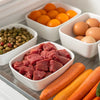Is Raw Dog Food Safe? Understanding the Risks and Benefits
- Houndsy
Table of Contents
- Introduction
- The Growing Trend of Raw Dog Food Diets
- The Health Risks Associated with Raw Dog Food
- Best Practices for Feeding Raw Dog Food Safely
- Alternatives to Raw Dog Food
- Conclusion
Introduction
Have you ever been intrigued by the idea of feeding your dog a raw diet, only to be confronted with a whirlwind of conflicting opinions? You're not alone. With the rise in popularity of raw dog food diets, many pet owners are left wondering: Is raw dog food safe? In fact, a recent industry report indicated that approximately 15-25% of pet owners are now incorporating some form of raw food into their dog's diet. While this approach is rooted in the belief that it mimics the natural diet of wild canines, the implications for our pets' health—and our own—warrant careful consideration.
In this blog post, we aim to dissect the safety of raw dog food by examining its benefits and risks based on scientific research and expert perspectives. We will cover critical questions, such as the nutritional adequacy of raw diets, the presence of harmful bacteria, and what owners can do to minimize risks if they choose to feed raw. By the end of this post, we hope to provide you with a comprehensive understanding of raw dog food, equipping you with the knowledge needed to make informed feeding decisions for your beloved pet.
Let’s dig into the conversation about raw dog food safety, posing some reflective questions along the way: How do you feel about the food options available for your furry friend? What considerations do you keep in mind when selecting the best diet for their health and well-being?
The Growing Trend of Raw Dog Food Diets
The concept of feeding dogs raw food isn't a new trend; it dates back to the early 1990s when veterinarian Ian Billinghurst popularized the BARF (Bones and Raw Food) diet. Advocates of raw diets assert numerous benefits, including shinier coats, cleaner teeth, and improved overall health. However, this rise in popularity doesn’t come without significant caution.
Dietary changes are often inspired by the desire to provide pets with a diet that resembles what their ancestors consumed in the wild. Dogs are omnivores and possess dietary flexibility compared to their carnivorous counterparts, such as cats. Raw dog food diets generally include muscle meat, organ meats, bones, fruits, and vegetables.
Benefits of Feeding Raw
Proponents of raw diets assert several benefits. Although scientific backing is mixed, here are some commonly cited advantages:
- Enhanced Coat Health: Many owners report shinier, healthier fur in pets that switch to raw diets, likely due to the higher fat content in raw meat.
- Improved Digestive Health: Raw food is thought to be easier for dogs to digest, promoting healthy stools.
- Healthier Teeth: Chewing on raw bones is theorized to promote dental hygiene.
- Increased Energy Levels: Supporters claim that a more natural diet leads to active, vibrant pets.
These purported advantages resonate with many pet owners striving to give their dogs the best life possible. However, we must also discuss the potential downsides.
The Health Risks Associated with Raw Dog Food
While the prospect of feeding dogs a raw diet might be appealing, several health risks cannot be overlooked. The Centers for Disease Control and Prevention (CDC), the U.S. Food and Drug Administration (FDA), and various veterinary organizations have expressed concerns regarding the contamination levels commonly found in raw dog food.
Bacterial Contamination
A significant concern is the high incidence of harmful bacteria present in raw food. According to research conducted by the FDA’s Center for Veterinary Medicine, about 25% of commercially available raw pet food tested positive for Salmonella or Listeria monocytogenes. These bacteria can pose risks not only to the dog but also to humans who come into contact with the contaminated food or surfaces.
- Salmonella: This bacteria can cause serious gastrointestinal illness in humans, leading to fever, diarrhea, and nausea. Dogs may carry Salmonella without showing symptoms, making them potential infectious agents.
- Listeria: Less common than Salmonella, listeriosis can lead to severe outcomes, especially in vulnerable populations, such as pregnant women and immunocompromised individuals. Listeria can also be shed in a dog’s feces, potentially endangering household members.
Nutritional Concerns
Not all raw dog food diets are created equal, raising questions about their nutritional adequacy. There are two primary categories of raw diets:
-
Commercial Raw Diets: While some commercial diets are formulated to meet AAFCO standards for nutritional adequacy, others may lack vital nutrients. Pet owners must be cautious and ensure they choose brands that provide balanced meals.
-
Homemade Raw Diets: These often lack proper formulation, leading to possible deficiencies in essential vitamins and minerals. Only recipes vetted by a veterinary nutritionist should be considered truly “complete and balanced.”
Improperly balanced homemade diets can lead to issues such as bone fractures from inadequate calcium levels or gastrointestinal problems stemming from excess protein.
Health Implications for Owners
Handling raw dog food also involves risks to human health. Many owners may inadvertently transfer pathogens to their mouths through improper hygiene after food preparation. Therefore, it’s crucial for pet parents to establish effective handling protocols.
Best Practices for Feeding Raw Dog Food Safely
If you choose to include raw food in your pet’s diet, adopting safe handling practices is essential. Here are our recommendations:
- Thorough Hand-Washing: Always wash your hands with warm, soapy water for at least 20 seconds after handling raw food.
- Clean Surfaces and Utensils: Disinfect all surfaces and tools that come into contact with raw food. Use hot, soapy water, followed by a disinfectant solution.
- Separate Food Storage: Use dedicated dishes and equipment for your dog's raw food to avoid cross-contamination with human food.
- Proper Thawing: Always thaw raw meat in the refrigerator, never on countertops, to minimize bacterial growth.
- Waste Management: Immediately dispose of uneaten food and clean any surfaces or items that have been in contact with it.
Implementing these practices not only protects your health but also ensures a safer feeding experience for your dog.
Alternatives to Raw Dog Food
For pet owners who are reluctant to adopt a raw dog food diet, a plethora of alternatives exist. These options can still promote comprehensive pet health while minimizing risks:
Cooked Home-Prepared Diets
Cooking for your pet provides control over ingredients while mitigating bacteriological risks. A diet prepared by you can be well-balanced, provided you include a variety of necessary nutrients.
High-Quality Commercial Dry or Wet Diets
Choosing high-quality commercial pet foods made with wholesome ingredients can be beneficial. Look for options that meet or exceed AAFCO standards for nutritional adequacy.
Balance with Raw Treats
If you want to provide the excitement of raw feeding while minimizing risks, consider implementing raw treats within an otherwise cooked or commercial diet. Many dogs enjoy raw fruits and veggies, or small amounts of raw meat used sparingly.
Conclusion
As responsible pet owners, our primary objective is to ensure the health and well-being of our furry companions while also protecting ourselves. Although raw dog food diets can present potential benefits, the associated risks—ranging from bacterial contamination to nutritional imbalances—should not be underestimated.
Throughout our examination, we've highlighted the importance of safe handling practices, alternatives, and the necessity for ongoing research in this evolving area of pet nutrition. Ultimately, the decision rests with you, the pet owner, to determine what works best for your dog's unique needs.
We encourage you to consider your current feeding practices. Have they evolved since you first brought your dog home? Are you prepared to make informed choices about their diet? And remember, regardless of how you choose to feed, whether through homemade meals, commercial diets, or raw food options, there are tools available to make this experience both safe and enjoyable—like the Houndsy Kibble Dispenser, designed to simplify pet feeding. Explore the Houndsy Kibble Dispenser and elevate your dog's feeding experience today!
FAQ
Q: Is it safe for all dogs to eat a raw diet?
A: No, not all dogs should eat a raw diet, especially those with compromised immune systems, health conditions, or puppies who require specific nutrient ratios for growth.
Q: Can raw dog food make humans sick?
A: Yes, raw dog food can carry harmful bacteria like Salmonella and Listeria, which can infect humans who handle it without proper hygiene.
Q: How can I tell if a raw food diet is nutritionally balanced?
A: Always choose raw diets that have a nutritional adequacy statement from reputable manufacturers. For homemade diets, consult a veterinary nutritionist.
Q: What if my dog gets sick after eating raw food?
A: If your dog shows signs of illness—such as vomiting or diarrhea—contact your veterinarian immediately.
By navigating the complexities of raw dog food diets with accurate information and a commitment to safety, we can ensure our pets thrive while enjoying their daily meals.












